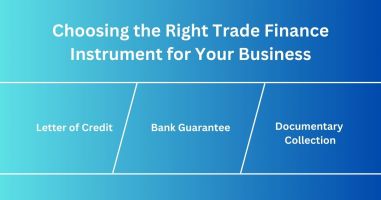Purchase Order Financing Guide: Process, Pros, and Cons

In order to run a successful business, entrepreneurs must manage cash flow effectively. A company's ability to grow and meet customer demands is often limited by the gap between receiving a purchase order and fulfilling it. Your business needs Trade instruments to stay afloat and thrive in this uncertain economy. The purpose of this blog is to provide you with information about Purchase Order Financing, including its pros and cons.
What is purchase order financing?
It is often mistaken for invoice factoring to be purchase order financing, but there is no comparison between the two. The purchase order process involves obtaining funds from a lender to meet a large order's capital requirements. Export Financing can prevent businesses from losing business if they do not have the cash flow to fulfill an order.A lender provides funds to the company to pay suppliers through purchase order financing. Invoices are sent to the customer once the finished goods have been received from the supplier. Once the invoices are cleared, the lender receives the money back from the company.
Despite the fact that any business owner can use purchase order financing as a funding option, the following businesses can benefit most from it:
1. Goods distributors
2. The exporters
3. The importers
4. The resellers
5. The wholesalers
To obtain business financing from purchase order financing companies, companies must meet certain requirements. In addition to a decent credit score for Bank Guarantee, you need a good reputation with suppliers and customers.
Understanding Purchase Order Financing
Businesses can access funds to fulfill customer orders with Purchase Order Financing, a short-term financing option. A company that deals with large orders or unexpected orders and lacks the capital to purchase raw materials or products needs this type of financing.The Process:
Receiving a Purchase Order:
When you receive a confirmed purchase order from a reputable customer, the process begins.Assessment:
Lenders will evaluate the purchase order and the Letter of credit of your customers. Additionally, they will determine whether you are capable of fulfilling the order.Approval:
If the lender approves the financing and specifies the fees and terms, they will approve the Export Financing and Import Financing.Funding:
To pay suppliers or manufacturers, you can use a percentage (typically 80-90%) of the purchase order value provided by the lender.Order Fulfillment:
With the funding, you can now fulfill the order and deliver the products to your customer.Invoice Settlement:
Your business will receive the remaining amount from the lender after the customer pays the invoice and the lender deducts its fees.The Pros:
Improved Cash Flow:In order to fulfill orders without having to wait for payment from customers, Purchase Order Financing bridges the cash flow gap.
Business Growth:
Having access to financing allows your business to accept larger orders and expand without being restricted by Import Finance.
Customer Trust:
Fulfilling large orders promptly can enhance your reputation and increase your customer's trust, which may lead to repeat business.
No Debt Incurred:
As long as your customer's creditworthiness is good, you won't accumulate debt with Purchase Order Financing.
Quick Processing:
Compared to traditional loans, Purchase Order Financing typically takes less time to apply and approve.
The Cons:
Costly:Purchase Order Financing can be more expensive than traditional loans due to higher fees and interest rates.
Limited to Creditworthy Customers:
It is common for lenders to only finance orders from customers with good Letter of credit, which limits the number of potential transactions.
Loss of Profit Margins:
Purchase Order Financing fees, especially for smaller orders, can eat into your profit margins.
Dependency on Customers:
It may be difficult for you to access financing if your customers have poor credit, which could limit your growth.
Not Suitable for Startups:
Businesses with existing purchase orders and a proven track record are more likely to be able to qualify for Purchase Order Financing.
Explore some Purchase Order Financing Examples.
Small Business Inventory Purchase:To meet customer demands without straining their cash flow, retail businesses use purchase order financing to replenish inventory for the upcoming holiday season.
Manufacturing Expansion:
Using purchase order financing, a growing manufacturer expands production capabilities and captures valuable business opportunities with a substantial order from a new client.
Importing Goods:
Importing businesses use purchase order financing to satisfy customer demand and expand their product line while managing cash flow challenges.
Seasonal Production Boost:
In order to meet customer demands promptly and efficiently during peak demand, seasonal manufacturers use purchase order financing.
Wholesaler Bulk Purchase:
In order to meet a retailer's substantial order and gain a competitive advantage, wholesalers use purchase order financing.
Conclusion:
In times of cash flow challenges and opportunities for growth, International Trade finance Services can be a valuable tool for companies. It is important, however, to carefully consider your business's needs, loan costs, and customer creditworthiness before selecting this option. Furthermore, it's advisable to evaluate other funding options and compare their benefits and disadvantages. You can improve your overall financial stability with the use of Purchase Order Financing when used strategically.
Ensure that Purchase Order Financing aligns with your business goals and financial circumstances by consulting with financial experts. This financing option can be a game-changer for your business if you plan carefully and execute it correctly.
Frequently Asked Questions
1. What is Purchase Order Financing?Purchase Order Financing is a short-term funding solution that helps businesses fulfill large orders by providing upfront cash to pay suppliers, ensuring timely delivery and meeting customer demands.
2. How does Purchase Order Financing work?
When a business receives a large order but lacks sufficient funds, they approach a financing company that pays the supplier directly. After fulfilling the order and receiving payment from the customer, the financing company deducts their fees and remits the remaining amount to the business.
3. What are the benefits of Purchase Order Financing?
Purchase Order Financing allows businesses to accept and fulfill more significant orders, expand production capabilities, improve cash flow, and avoid equity dilution or taking on debt.
4. Are there any downsides to Purchase Order Financing?
While Purchase Order Financing provides immediate cash flow relief, it can be more expensive than traditional financing options, and businesses with low-profit margins may find the fees challenging to absorb.
5. Is Purchase Order Financing suitable for startups and small businesses?
Yes, Purchase Order Financing can be beneficial for startups and small businesses that face cash flow constraints and need assistance in fulfilling large orders to grow their operations.






